
Sacred City of Anuradhapura
Anuradhapura is a former political and religious capital of ancient Sri Lanka, established around the Third Century BC. It is home to some of the most revered sites of worship for Buddhists, including the Sri Maha Bodhi, a branch of the original Jaya Sri Maha Bodhi (Tree of Enlightenment) in India. The city is visited today by hundreds of pilgrims and tourists alike each day, who come to explore the ruins of a city that was a testament to the island’s Golden Era.

The Sacred City of Polonnaruwa
The sacred city of Polonnaruwa was the second political and religious capital of ancient Sri Lanka, following the fall of the Anuradhapura Kingdom after an invasion by South Indian Chola rulers. The Polonnaruwa Period lasted between the 11th and 13th Centuries AD. Interestingly, the location of this new city was chosen because of its strategic positioning, which would help the Chola rulers resist attacks by the Sinhalese armies. However, the city was finally claimed by King Vijayabahu in 1070, who chose to keep Polonnaruwa as the capital.

Ancient City of Sigiriya
Sigiriya is perhaps one of the most recognizable tourist attractions in Sri Lanka, with its world-famous rock fortress treated as an icon of ancient Sri Lanka. It is also one of the most visited sites in Sri Lanka, simply because of its awe-inspiring complex of moats, ramparts and water tanks, which boast engineering that were far ahead of its time. On top of this massive rock also lies ruins of a once-magnificent palace complex, from which the view of the water tanks below, and surrounding forests and hills are breathtaking.
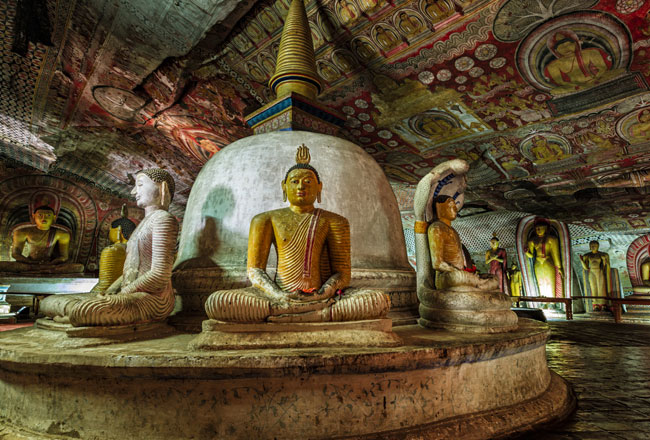
Dambulla Golden Temple + Cave Temple
Dambulla is an ancient city that, along with Anuradhapura and Polonnaruwa, forms the Cultural Triangle of Sri Lanka. Although Dambulla as a kingdom was smaller than its predecessors, it is still home to some of the most important historical and religious sites in the country, and is close to ancient city of Sigiriya.
Amongst the attractions in Dambulla is the famous Golden Temple, which is located on. Rock that rises 1,118 feet from ground level. The Golden Temple is fascinating for its visitors because of the many caves that can be found in its premises. Many of these caves are filled with beautiful idols of the Buddha as well as vibrant rock paintings.
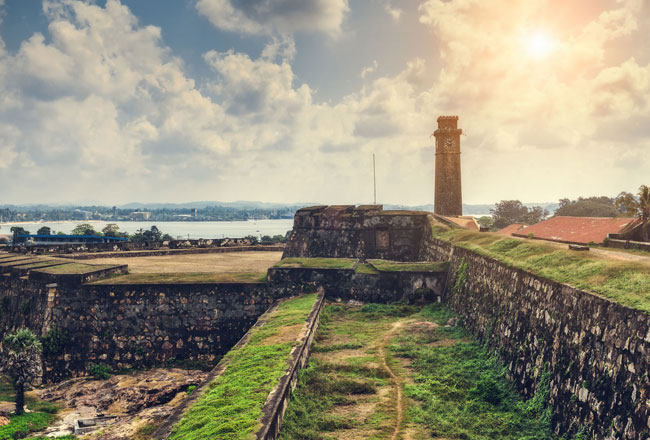
Galle Fort
The Galle Fort in Sri Lanka is perhaps the most popular attraction for both tourists and locals today. With an impressive structure that has become the icon of the city of Galle, the fort is so intoxicating because of its fascinating complex of buildings, people and stories. Much of its architecture remains untouched, but whilst it was mostly filled with residents whose families had lived there for generations until recently, today it is home to chic boutique hotels, luxury clothing and jewellery stores, upscale art galleries and fancy restaurants.
Although it is popularly referred to as the Dutch Fort, mostly due to its heavy Dutch influence, the original fort was built by Portuguese colonists in the 15th Century. After the Dutch successfully took over rule of Galle in 1640, its most significant constructions took place. The most prominent feature of the fort is the ramparts, constructed with granite to an impressive height and width. The streets that run through the fort are also very characteristic of the planning of Dutch cities, as are the many of the homes that are still around today. The Dutch Reformed Church is perhaps one of the most visited sites within the fort, especially for the stately tombs and memorials for early Dutch residents in its outer garden.
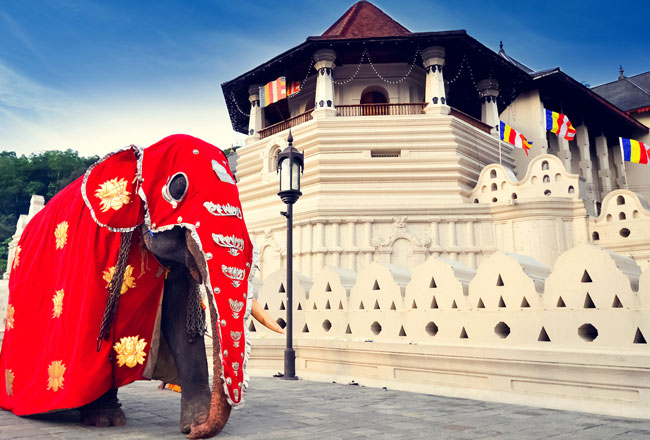
Sacred City of Kandy
The sacred city of Kandy was the last Sinhala Kingdom of Sri Lanka, before the British Empire declared an islandwide rule in 1815. However, it first came into existence as far back as the 12th Century AD, during the reign of King Vikramabahu. Today, it is most known the Temple of the Sacred Tooth Relic, which houses what is believed to be the remnant of a tooth that belonged to Lord Buddha.
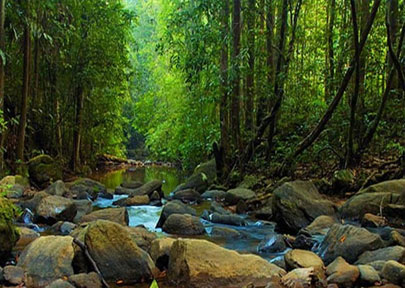
Sinharaja Forest Reserve
The Sinharaja Rain Forest is one of the most important natural reserves in Sri Lanka, and its rich biodiversity is a symbol of pride in the country. The rainforest lies in the tropical lowland and wet zone areas of the island, between the Southern and Sabaragamuwa Provinces. Sinharaja can be accessed from three sides, most popularly from Ratnapura, Kiriella, Kalawana, Weddala, Deniya or Rakwana.
The total area of the Sinharaja Forest Reserve is 18,900 acres and its altitude ranges from 300 to 1,170 meters. Sinharaja is one of the most closely guarded attractions in Sri Lanka because it is home to over 50% of the country’s endemic species, of mostly mammals and butterflies but also insects, reptiles and amphibians. Due to this, the forest was first declared a ‘forest reserve’ way back in 1875, under the Waste Lands Ordinance. However, it was only in 1988 that it became Sri Lanka’s first National Wilderness Heritage Area. The same year, it was declared a UNESCO World Heritage Site.

Central Highlands of Sri Lanka
Sri Lanka’s highlands are situated in the south-central part of the island. The property comprises the Peak Wilderness Protected Area, the Horton Plains National Park and the Knuckles Conservation Forest. These montane forests, where the land rises to 2,500 metres above sea-level, are home to an extraordinary range of flora and fauna, including several endangered species such as the western-purple-faced langur, the Horton Plains slender loris and the Sri Lankan leopard. The region is considered a super biodiversity hotspot.
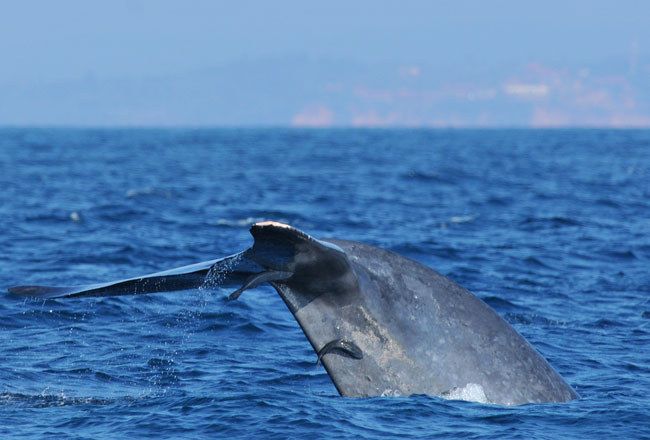
Whale Watching in Mirissa
Perhaps one of the most delightful excursions you can take from the Southern coast of Sri Lanka is to go whale watching in Mirissa. This charming coastal city has many locals and tourists visiting during the months between November and April, who are keen on spotting blue, sperm and killer whales out in the ocean.
Spot a blue whale has become a must-do activity in Sri Lanka. The blue whale, considered an endangered species, is a rare sight at all other times. Its beauty lies in its enormous size, which is breathtaking when seen in the blue waters that surround the island. It hardly shows up more than a small area of its body on the surface of the water, but on a lucky day, when it does, it can be a real feast for the eyes.
A whale watching excursion is also not complete without the many dolphins that can be spotted on the way and the spinner and bottle-nosed dolphins are famous for their playful antics. Most excursions begin very early in the morning and wrap up by noon, as these are the hours that are best for seeing these glorious creatures in the sea.
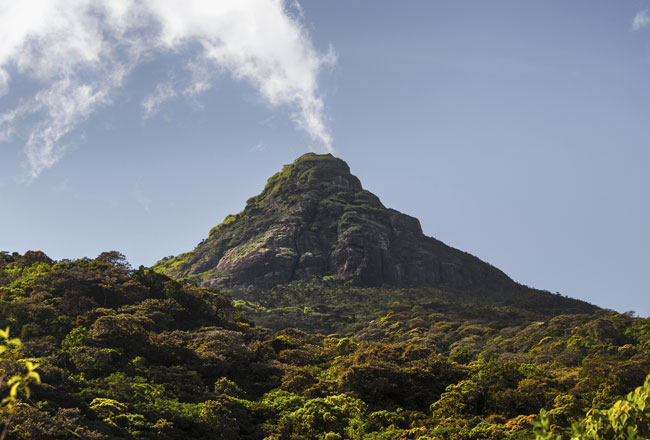
Adam’s Peak
The significance of Adam’s Peak in Sri Lanka is unique; it is considered sacred to all four major religious communities in Sri Lanka, the Buddhists, Hindus, Christians and Muslims. Each community has its own tale of the mysterious Imprint on the peak of this rock, attributing to a legend of their own faith. Regardless of its origin, Adam’s Peak is today one of the most revered sites in Sri Lanka, with thousands of pilgrims flocking to climb to its top as an act of their devotion, each year.
Adam’s Peak stands at an amazing 7,329 feet from sea level. It is referred to as Sri Pada by Buddhists of the country, who believe the Lord Buddha left his footprint on its peak during k e of his three visits to Sri Lanka from his native India. (The word ‘pada’ means foot in Sinhala). Hindus refer to it as Shivan Adi Patham, which translates to ‘the creative dance of Lord Shiva’. They believe this ‘footprint, belongs to Shiva. Although it is not a firm belief, Christians attribute this print to Adam. This stems from the belief that God chose a place that mostly closely resembled Paradise before casting him out, leading Adam to first step foot on Earth on this rock. Some Christians also believe it is the footprint of S. Thomas, who introduced Christianity to South India in 50 AD. Muslims, who treat Adam as one of their prophets, also hold the peak sacred for the same reason.
Climbing up to the summit of Adam’s Peak is an exhausting experience but it’s considered one of the most rewarding for pilgrims of all faiths. There are three routes to get to the very top. The most popular route remains the one that starts from Maskeliya as it is the shortest. Others prefer the route that begins from Ratnapura, despite its length, because of its scenic beauty. Pilgrimages often begin at night, with many hoping to reach to the top in time for the sunrise, or ‘ira-sevaya’. There are many shelters and little shops along the way for pilgrims to rest and refresh themselves. The temple at the peak is considered a must-visit by Buddhists, where one can worship.
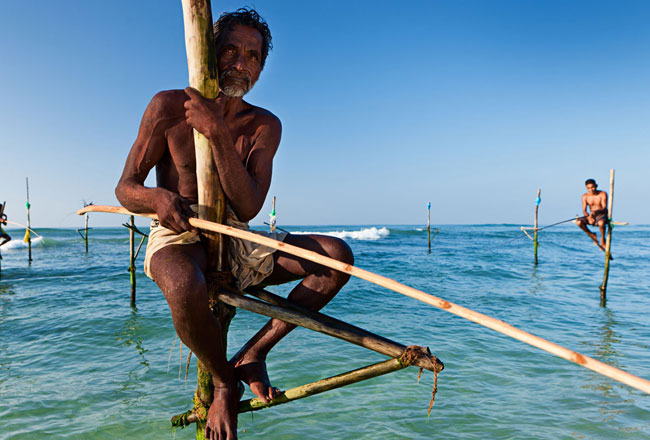
Ahangama - Stilt Fishermen
One of the most phenomenal sights one will encounter on a drive down to the Southern coast of Sri Lanka is the stilt fishermen, particularly in the little town of Ahangama. It is a very recognizable form of fishing, where the fishermen stands quietly on a tall frame made of sticks and twine, waiting for their next catch. What came about as a solution for abject poverty is now a very profitable tourist attraction.
According to an article published on Wired, stilt fishing, despite popular notion, is not very ancient. In fact, it only came about around 70 years ago. During the Second World War, there were food shortages in the island. It is also believed that the technique was developed when regular fishing spots, such as rocks and cliffs, became too crowded, around the same time. At first, the fisherman of villages near Galle to use wreckage of ships and airplanes to catch by staying on the water.
Later, this method evolved to what is known as stilt fishing today. A vertical pole is fixed to the seabed, and a shorter cross bar, called the petta, is attached to it. The fishermen usually stand, or balance themselves, on this cross bar. Most often, this method takes many hours before the fishermen can make a big enough catch. They have to hold the stilt with one hand, while holding the fishing rod on the other. They also mostly catch smaller varieties of fish, such as spotted herrings and mackerels, which they usually slip into small plastic bags that are tied to their waist or to the pole. Stilt fishing takes place daily during sunrise and sunset, and many fishermen take a hiatus during the monsoon period.
Although the Indian Ocean Tsunami devastated most fishing families in 2004, because it permanently changed the shoreline of the island, it is not impossible to catch some of the stilt fishermen around Ahangama. Especially if caught during good weather conditions during local fishing times, they can be mesmerizing to watch – and make for some great photo memoirs.

Arugam Bay - Surfing
An almost too-quiet village till around ten years ago, Arugam Bay is now considered one of the hottest destinations in Sri Lanka, particularly for its waves during surf season. Located in the east coast of the island, around an eight hours’ drive from Colombo, this village today draws in surfers and young travellers from all corners of the world, between the months of May and September. Arugam Bay also hosts several international surfing competitions each year, during this season.
However, its recent popularity does not mean this charming village wasn’t a surfers paradise before. It is said that in 1950s, around the time surfing culture took over the coastal cities in the United States, a few American engineers working in Sri Lanka discovered that Arugam Bay was a good place to surf. In the 60s and 70s, a few hippies and expats would come out to the east coast to surf, and only less than a handful of guest houses sprung up in the area in the years later, due to the war.
Today, the area of Arugam Bay has come alive, with many hotels, guest houses, restaurants and cafes, especially along the famous ‘Arugam Bay strip’. During the season, the village is buzzing although it still retains much of its quiet charm – quite unlike popular beach destinations in the south of the island that have become very commercial, expensive and ‘touristy’ over the last few years.
But most importantly, Arugam Bay still remains the first choice of surfers, from pro to amateur. There are many great locations that are considered ideal for surfing, such as the Main, Pottuvil, Cobra, Panagala, Okanda and Whisky Points as well as Peanut Farm, Komari, Panama, and Elephant and Crocodile Rock. The famous waves of this region are fueled by the Southwest Monsoon, and are conducive for surfing at all levels because of their consistent swells, wave breaks and long right hand runs.
If you are still new to surfing, there are a few surf schools and instructors with whom you can easily book a session. And if you simply enjoy being in the waters without surfing, there are also many points that are great for swimming.

Kalpitiya - Kitesurfing
Kitesurfing is as close to surfing as you can get, minus the advanced techniques. It literally allows you ride a modified surfboard, which you can ride while holding onto a specially designed, propelled kite. Kitesurfing, when pursued as a sport, uses a combination of aspects of surfing, paragliding, wakeboarding, windsurfing, and gymnastics.
In the little fishing village Kalpitiya, which is located on the west coast of Sri Lanka, on the peninsula of Puttalam, you can kitesurf for fun or as a sport. In fact, besides dolphin watching, kitesurfing has become one of the main reason most locals and tourists travel up to Kalpitiya. The area is known for its high winds, which averages around 18-25 knots during the high season, between the months of May and September. The months from December to March are called the ‘mini kitesurfing season’ and is great for some light kitesurfing.
There are several types of kitesurfing that you can try out, such as flatwater, lagoon and waves and many kitesurfing schools offer the option of surfing either in the ocean or lagoon. Most kitesurfing sessions come with a little training session, because as fun as kitesurfing is, it is not easy to master it on the first try. The lagoon is the best place to take some lessons as well as try out freestyle kitesurfing. More advanced surfers can ride the 500m wave that appears during the Southwest Monsoon.
Another exciting programme offered by schools in the area are kitesurfing safaris, which are short excursions to beautiful islands or other attractions, where you can kitesurf as well as explore or swim. More experience kiters can visit places like Dream Spot (or Vella), Donkey Spot (Sethawadiya Lagoon) or the Kappaladi Lagoon, where you can enjoy different styles of kitesurfing.
There are also many other activities you can enjoy while taking a break from kitesurfing, such as swimming or snorkelling, at Kalpitiya is a marine sanctuary with many gorgeous sea creatures to be seen. You can even explore its swamps, or buildings left over from the Dutch Period, whose architecture is typical of colonial structure and design of the time.
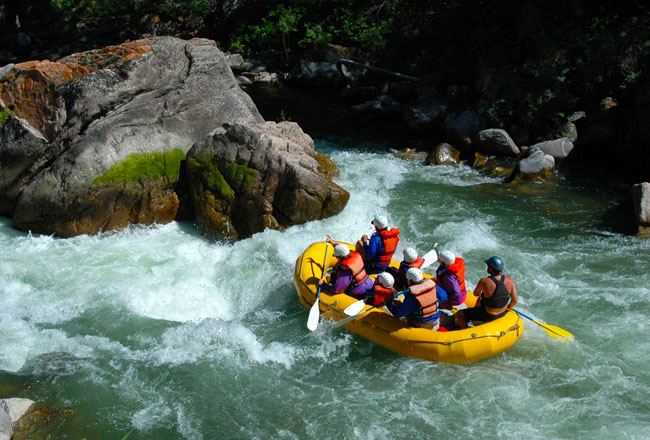
Kitulgala Whitewater Rafting
Whitewater rafting has been a hugely popular activity in Sri Lanka for many years, appealing to both daredevils and nature lovers alike. It involves navigating whitewater on an inflatable raft, and while it may look difficult, it is considered an activity that is not just fun but also requires team skills. Perhaps this is why whitewater rafting has always been an activity pursued by companies and organisations and outbound training for their employees.
One of the most popular destinations for whitewater rafting in Sri Lanka is the green and picturesque region of Kitulgala. The village gets its name from the vast number of kithul trees in the area, which is a palm tree from whose sap is derived to make the local sweetener, jaggery. Kitulgala is located around 80 kilometres outside Colombo, which can be reached in an hour-and-half by road. Kitulgala was also the filming location for the famous Hollywood movie, Bridge on the River Kwai.
Whitewater rafting in Kitulgala takes place on the Kelani River of Sri Lanka, in the areas where whitewater occurs. Whitewater is created when a river’s gradient increases enough to cause turbulence and entrain air in its body. Because of whitewater rafting is only safe during the months between May to December, when there are no monsoon rains.
There are five rapid in which you can raft, and they are graded between Class 2 and 3, according to international rafting standards. They are even given names – Head Chopper, Virgin’s Breast, Butter Crunch, Killer Fall and the Rib Cage. There are several companies with which you can book a whitewater rafting session, and they usually provide all passengers with all the safety gear required.
Although challenging, whitewater rafting can be a great exercise in team coordination and navigations. Also, being splashed with the cooling waters of the Kelani River is both refreshing and fun, and a welcome change from the humid weather.
Once you are done with your whitewater rafting excursion, you can also explore the quaint village of Kitulgala or even go birdwatching. Many birds that are seen in the Sinharaja Rain Forest can also be spotted in this area.
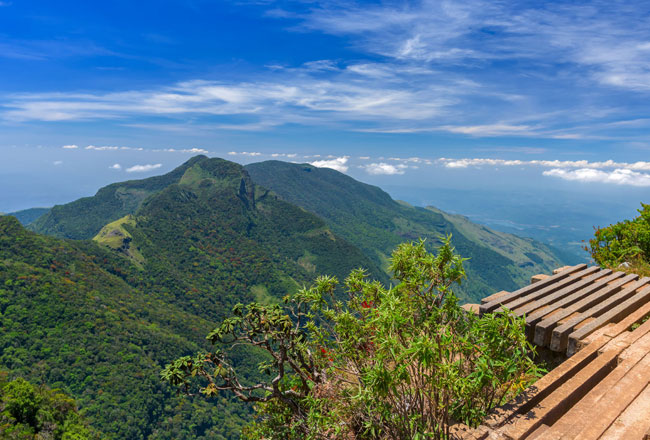
World’s End Drop
To travel to the World’s End in Sri Lanka is considered one of the most beautiful excursions. It gets its name simply from the views it offers endless stretches of mountain tops and sky – almost as if no civilization exists beyond where one is standing.
The World’s End can be accessed through the Horton Plains National Park, which is situated in Nuwara Eliya, a hilly town of Sri Lanka that enjoys mild to chilly weather all year around. Once at the park, the main cliff is around four kilometres away. The trail also leads up to Baker’s Falls, from which you can walk back to the entrance – all within three hours. The temperature around the World’s End is usually between 16 to zero degrees, depending on the time of year. The best time to see the World’s End drop is before sunrise, before it is shrouded in mist and obscures any view of the surroundings, therefore it is best avoided between April and September.
The unique ecosystem around World’s End, where cool temperatures, high altitude and the merging of three major rivers, lends itself to rich biodiversity. It is not impossible to see leopards, fowl, deer and other fascinating creatures on the way to World’s End.
There is also a smaller cliff around a 20 minutes’ walk away from the main cliff, often referred to as the Small World’s End. It is believed to have a spectacular drop – even more beautiful than the view from the main cliff, according to some – that also draws in many tourists during the season.
Keep in mind, however, that besides sound health and fitness levels, it also recommended to come well prepared for an excursion. Travellers are recommended to bring warm clothing, plenty of water and food. Perhaps most importantly, travellers are asked to stay close to the trail and not wander off, as many have met with their death by falling off. Once you reach the entrance of the trail, it is easy to find guides who can take you to both cliffs, for a small fee.
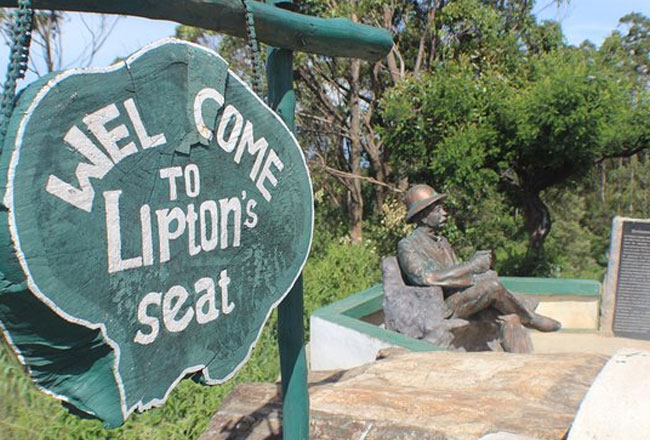
Lipton’s Seat
Lipton’s Seat offers some of the magical views of the tea plantations of the Haputale region, a testament to the many years of British Rule in Sri Lanka, when tea first became a major industry in the island. It is believed that this was the spot from which Sir Thomas Lipton enjoyed watching over his plantations.
It is said that Scottish-born Sir Lipton visited Sri Lanka (then Ceylon) in 1890 and met James Taylor, who is credited for establishing the first tea plantations in the country by employing South Indian Tamils to work on the estates. Sir Lipton, who by then ran a highly successful business in imported foods and beverages, made a deal with Taylor and began importing Ceylon Tea under the Lipton brand to the United States and United Kingdom.
Lipton’s Seat is located on the Poongala Hill, near the Dambatenna Tea Factory that still stands today. It is a climb of around seven kilometres, which can be a very picturesque journey. Once you reach the top, you can see a radius that spans the Uva, Sabaragamuwa, Central and Eastern Province. On a clear day, it is even possible to see some of Sri Lanka’s most iconic attractions of the natural world, such as the Handapanagala Lake, Chandrika Lake, Udawalawe Lake, Wedihiti Kanda mountain range. Several stunning waterfalls can also been both from the seat as well as on the climb, such as St. Catherine’s Falls and Lemasthota Falls. If you are lucky, you could even see the Hambantota Harbour, which is located all the way on the southern coast of Sri Lanka. You can also access Lipton’s Seat from Bandarawela through the Nayabedda Estate.
The best times to make the most of your excursion to Lipton’s Seat is early in the morning, preferably around sunrise, to catch the first rays of sunlight hitting the lush, expansive tea plantations as well as the cooling mist settling in. The best months are considered March and August.
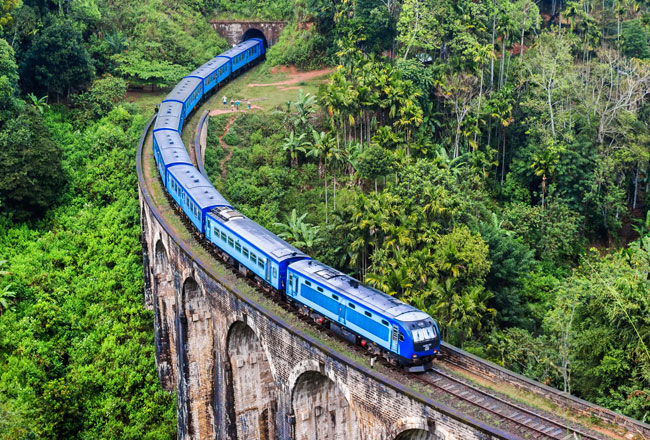
Demodara Railway
The Demodara Railway is one of the most unique railways in Sri Lanka and, possibly even, the region because of its interesting structure and surrounding natural beauty. It is also one of the most photographed train routes in Sri Lanka, celebrated as an engineering feat during the British Colonial Period.
The Demodara Railway Station is third last station on the Main Line of Sri Lanka’s railway system, with the two of the most popular trains – the Udarata Menike and Podi Menike – stopping at this station along its route. The most distinctive feature of this railway is its ‘loop’, where the railway wind itself under the station through a tunnel that was carved inside a mountain. The loop itself is around 900 metres in length, and the tunnel is 320 metres in length.
It is believed the inspiration behind this unique loop was drawn from the headgear of one of the workers who were involved in the construction of the railway. The engineers at the time saw him tie his talappa around his head in a loop, and were struck with the idea of designing a railway that would wind itself in a similar fashion. Others believe the engineers and surveyors, who were working on a rail extension to Badulla, realized the elevation between the hills in the area for too high for a railway to function, as the Ceylon Government Railway had a maximum elevation allowed. Hence, they had to think of a clever way to negotiate this and thus the loop was born, in February 1923.
The railway, though slightly neglected today, is still a magnificent sight, especially against the backdrop of surrounding mountains and forests. The railway is also characterized by its nine arched bridges, which is about two kilometres from Ella and make a breathtaking scene while travelling on this route.
The closest way to reach Demodara is to climb on a train from or to Badulla, which is a town located around 220 kilometres from Colombo.
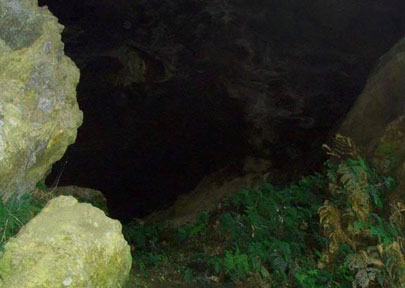
Ravana Caves
Sri Lankan folklore has many references to Ravana, the Hindu mythical figure in the Ramayana. Also known as the King of Lanka, he is believed to have kidnapped Princess Sita, the wife of King Rama, and hidden her in the island. This was supposed to be an act of vengeance upon Rama and his brother, Lakshmana, who apparently cut the nose of his own sister, Shurpanakha.
The Ravana Cave is one of several places in Sri Lanka in which locals believe Ravana kept Sita hidden. The cave itself is located in one of the most beautiful areas of the country, on a cliff in the Uva Province. It is also very close to Ella, which lies around 220 kilometres outside Sri Lanka – a drive of slightly over five hours.
The cave is supposed to be one of many caves connected to the Ravana Falls, one of Sri Lanka’s most visited waterfalls in the same region. There are also entrances to this series of caves at Ishtripura in Welimada, Senapitiya in Halagala, Ramboda, Labookelle, Wariyapola in Matale, and Seetha Kotuwa in Hasalaka.
It is believed he chose this cave to keep Sita because the cave served a secret passage through the hills and between all villages of the area. It also allowed them to stay hidden behind the cascading waterfall, which is about 30 feet tall, and Sita was supposed to have bathed in the water of a pool that was formed near the falls. The Ravana Falls originates from a tributary of the Kirindi River.
Locals who firmly believe in this legend also claim the characteristics of the cave prove it was a manmade cave, as opposed to a natural occurrence. The Ravana Cave lies at around 4,500 feet above sea level, and is definitely worth visiting for its beauty, which is of a somewhat mystical quality. The lush green mountains and cooling waters of the Ravana Falls make this a very popular tourist attraction in the area. It is also a famous stop for pilgrims visiting some of the most sites in the region.

Top five major waterfalls in Sri Lanka
As much as Sri Lanka is reputed for its gorgeous beaches as an island, it is also home to over 100 beautiful waterfalls. Most of these waterfalls are located in the central region of the country, where many mountain ranges lay and several major rivers originate from. These waterfalls are generally surrounded by lush greenery, charming villages and wildlife, making them a must-visit for all those travelling through the country.
The tallest waterfall in Sri Lanka is the Bambarakanda Falls, with a drop of 263 metres. Because of its location, within a forest in the Kalupahana area, it is not often visited. However, it certainly should be visited, simply for the sheer magnificence of its height and surrounding scenic beauty. Its fall is not very wide, and its water is formed by a tributary of the Walawe River and the Uduweriya Haputale Mountain. It can be accessed from Badulla.
One of the most visited falls is the Ravana Falls, which has one of the widest falls in the country and is in the dry zone of the Welimada area. However, its height is only 82 feet. Nevertheless, the Ravana Falls is popular of the graceful way in which its water falls over the rocks. It is also a place in which many travellers stop for a quick dips in its pools, although this must be done with great care for one’s own safety. Its fall also provides water to its nearby villagers, for their everyday use as well as for their cultivation.
The Diyaluma Falls is the second tallest waterfall in Sri Lanka, with a fall that is 220 metres. It lies around six kilometres from Koslanda, in the Badulla District. Like Bambarakanda, it is also not very wide but is still a stunning sight. The water from its fall flows to the Kirindi River under a bridge on the road from Beragala and Wellawaya, contributing to the breathtaking views of this area.
One of the most beautiful waterfalls in the country is the Dunhinda Falls, which lies about two kilometres away from Taldena, a quiet village in the Badulla District. It gets its name from the mist or water spray its enormous fall creates; the word dun in Sinhala means ‘vapour’. It is also one of the most visited waterfalls, by both tourists and locals.
Another waterfall is reputed for its peculiar beauty is the Devon Falls. It is formed by three continuous cascades, that fall down to the valley below. The fall in total is around 97 metres high, around 1,140 metres above sea level. The Devon Falls is best seen on the road from Colombo to Avissawella, from where you can see it sit majestically among green mountains.
Subscribe now! We will send you best offers for your trip.
 EVHolidays
EVHolidays
 +94 774 266 912
+94 774 266 912


